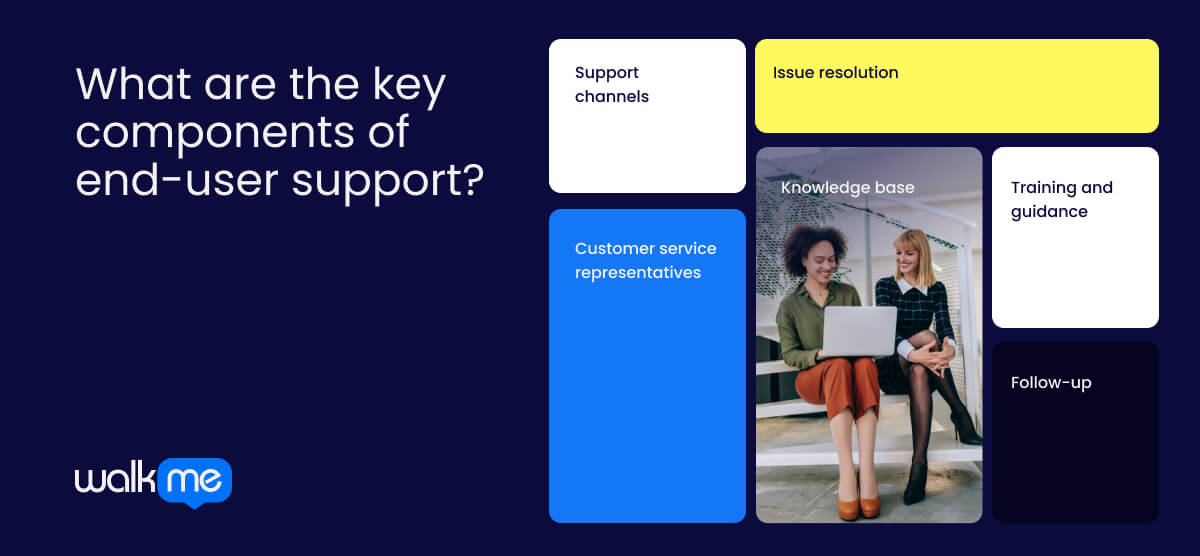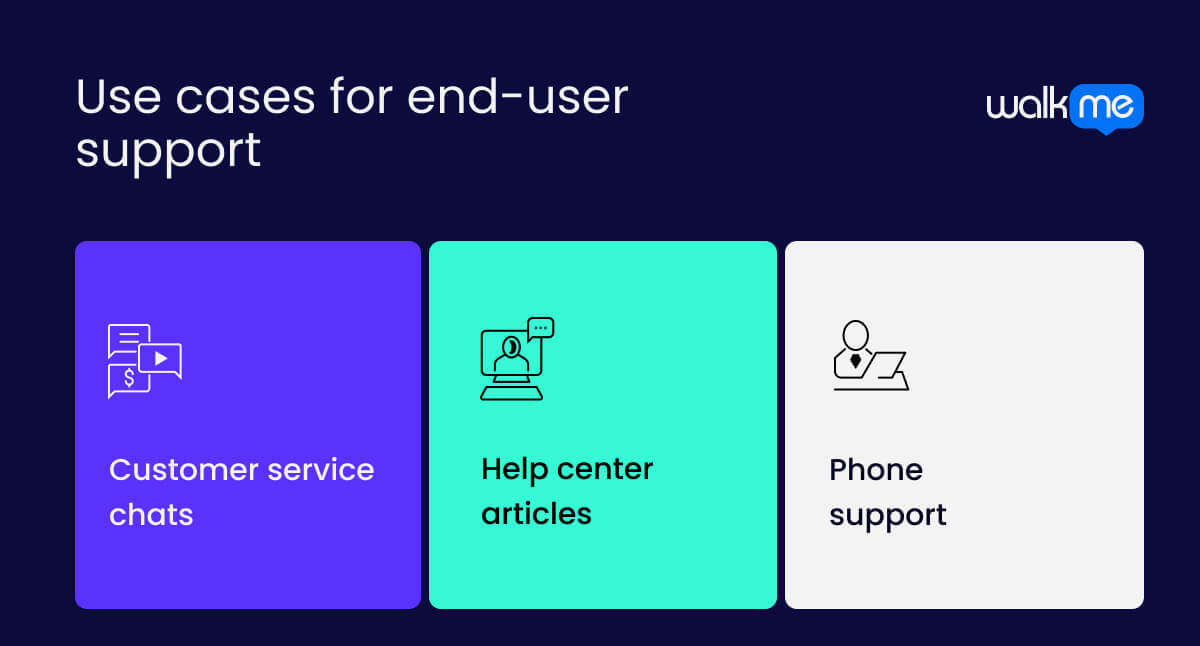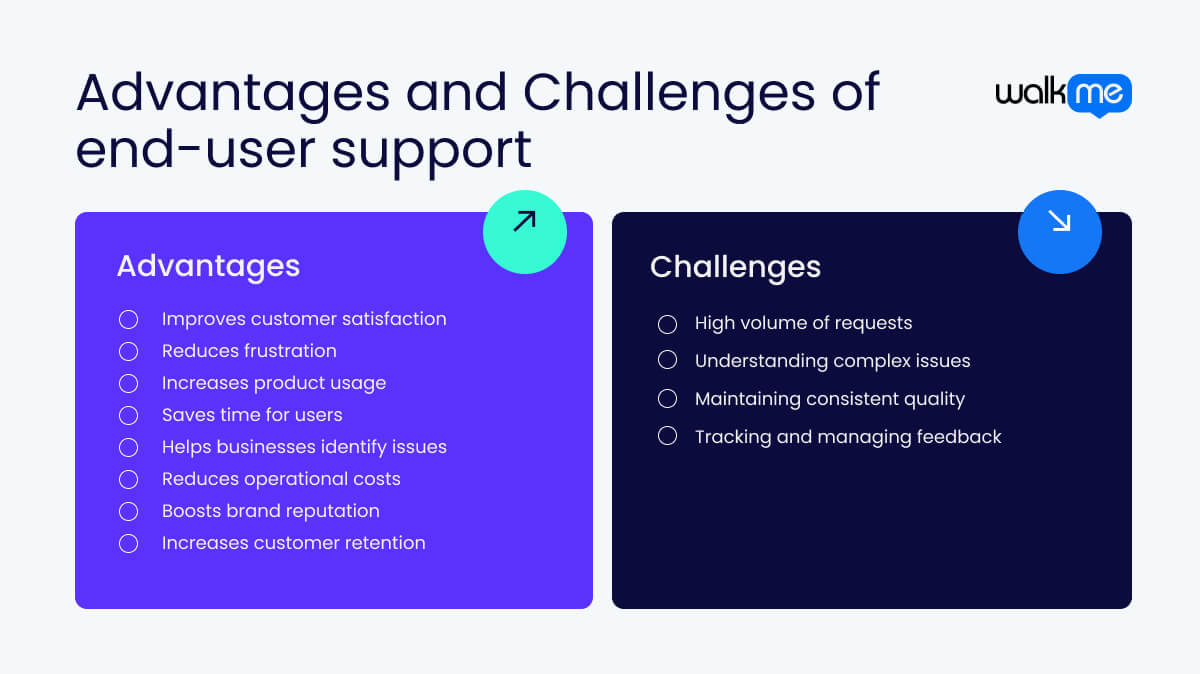What is end-user support?
End-user support is the help given to people who use a product or service. It helps users solve problems, answer questions, and make sure they can use the product or service correctly. The support might include fixing technical issues, explaining how to use certain features, or helping with any other concerns about the product.

Table of contents
Support can be provided in different ways, such as talking to customer service, using a help desk, chatting online, emailing, or finding answers in help guides or FAQs. It’s important because it helps ensure people are happy with the product. When users have problems or questions, they need support to help them quickly and in a helpful way.
End-user support also means keeping the product up to date. Steps could include fixing bugs, adding new features, or making improvements before announcing them via methods like in-app messaging. Sometimes, support also includes teaching users how to use the product better by offering guides or lessons, for example with interactive walkthroughs.
What are the key components of end-user support?

Understanding the key parts of end-user support is important for knowing how companies help their customers. These parts work together to make sure users can get the help they need quickly and easily.
From offering different ways to ask for help to giving useful guides, each part helps make the user experience better. Let’s take a look at the main parts that make end-user support work well.
Support channels
These are different ways users can get help. Common options include talking to customer service, chatting online, sending emails, calling on the phone, or using online guides and FAQs. Offering many ways to reach support makes it easier for users to find help when they need it.
Issue resolution
In other words, solving problems users face. Whether it’s a technical issue or a question about how to use a product, the goal is to fix it quickly. By solving problems effectively, users can keep using the product without major trouble, which gives them a good customer experience.
Knowledge base
A knowledge base is a collection of helpful information, like how-to articles, videos, and guides. It lets users find answers on their own without needing to contact support. A good knowledge base helps users solve problems quickly and gives them the tools to use the product better.
Customer service representatives
These are the people who help users by answering questions and solving problems. They make sure users feel supported and help guide them through issues. Customer service representatives are key to building trust and ensuring users are happy with the product.
Training and guidance
Resources like tutorials, step-by-step guides, or videos to help users learn how to use a product. These materials teach users how to get the most out of the product, making it easier for them to use it with confidence. Training helps reduce frustration and lets users enjoy the product more.
Follow-up
After solving a problem, it is important to check in with the user to make sure everything is okay. Follow-up ensures the issue is fully fixed and gives users a chance to ask any more questions. It also helps companies learn how they can improve their support and keep users satisfied.
End-user support vs. service desk
End-user support and service desks both provide help to users, but they focus on different types of issues.
- End-user support is broader and helps with any problems related to using a product or service
- A service desk is more focused on solving technical IT problems, like issues with computers or software
Let’s explore the differences between these two terms in more detail.
| End-user support | Service desk | |
| Definition | Help given to people who use a product or service. It solves problems and answers questions to make sure the product works well for the user. | A place where people get help with technology problems, like issues with computers, software, or networks. It helps fix things that stop technology from working. |
| Focus | Helps users with any issues they have using a product or service, like fixing problems or teaching them how to use it. | Focuses only on fixing technology problems, such as issues with computers, apps, or the internet. |
| Techniques | Giving instructions, chatting online, talking on the phone, or using guides to solve problems. | Tracking systems, remote help, and software checks to find and fix IT problems. |
| Goals | Help users use the product easily, solve their problems fast, and make them happy with the product. | Fix technology problems quickly, keep everything running smoothly, and make sure users can use their tech without problems. |
| Examples of use | Help someone set up a new app, fix a broken feature, or explain how to use a service better. | Fixing a computer, solving network problems, or making sure software is working right. |
Use cases for end-user support

End-user support can show up in many different ways depending on the business and the type of support needed. From helping customers troubleshoot issues with a product to providing quick answers through live chat or phone calls, end-user support can adapt to different situations.
It’s helpful to see how this support works in real-life business scenarios. Here are three examples that show how end-user support can be used in different ways.
Customer service chats
End-user support can include live chat on a company’s website. If a customer has a problem or question, they can start a chat with a support agent immediately. The support agent is there to guide them through troubleshooting steps or to answer any questions about the product or service.
The customer can fix their issue right away without having to wait for an email response or phone call. The live chat service makes the experience smoother, as the customer can continue using the product while getting help, and the company can resolve issues quickly.
Help center articles
Another way end-user support works is through help center articles or frequently asked questions (FAQs). These articles are online resources that explain how to solve common problems or answer questions customers may have about the product. The help center lets users search for answers at any time of day, so they don’t have to wait for a response from a support agent.
These articles cover things like setting up a product, fixing issues, and using advanced features. Users can find solutions on their own, saving both time for the customer and reducing the amount of support calls the company needs to handle.
Phone support
Some businesses offer phone support as a key part of their end-user service. When customers have a difficult problem or need a more personal touch, they can call a special phone number to speak directly with a support representative. The representative listens carefully to the issue and works with the customer to find a solution.
Phone support allows for more detailed help, whether fixing a technical problem, answering a billing question, or explaining how to use the product. This kind of support is especially useful when customers have complex issues that need a clear explanation or hands-on assistance.

What are the advantages of end-user support?
End-user support benefits businesses and customers. When companies help users quickly and easily, the experience improves for everyone. The end result is happier customers, more loyalty, and savings.
Let’s take a closer look at the main benefits of having good end-user support.
Improves customer satisfaction
End-user support helps customers solve problems quickly and efficiently. When users get the help they need without delays, they feel happier with the product or service. It can lead to better customer loyalty and positive reviews.
Reduces frustration
With effective end-user support, users don’t have to figure things out on their own. Whether through live chat, phone calls, or guides, customers can get answers quickly, reducing their frustration and making their experience more enjoyable.
Increases product usage
When users can easily access support, they are more likely to continue using the product. Good support also helps customers understand how to use features, which increases their engagement with the product.
Saves time for users
End-user support provides fast solutions to problems, which means users don’t have to spend time troubleshooting or figuring things out themselves. They can get back to using the product or service more quickly.
Helps businesses identify issues
By offering support, businesses can track common problems and understand what customers struggle with. It helps identify areas where the product or service can be improved.
Reduces operational costs
With effective support systems in place, such as self-service options or automated responses, businesses can reduce the number of direct customer service calls and emails. The cost of providing support is lowered, while still helping users.
Boosts brand reputation
When a company provides great end-user support, it builds trust and strengthens its brand. Customers are more likely to recommend the product or service to others, leading to better word-of-mouth marketing.
Increases customer retention
Customers who receive helpful and responsive support are more likely to stay with a brand. By resolving issues quickly, businesses can keep their customers happy and loyal for the long term.
What are the challenges of end-user support?
Now, let’s look at the challenges of end-user support. While good support is important for both businesses and customers, problems can make it difficult to provide. These challenges need to be solved so that support works well.
Let’s explore some of the main challenges businesses face when offering support to users.
High volume of requests
When many users need help at once, it can be challenging to keep up with all the support requests. It can lead to longer response times and frustrated customers. Handling a large number of inquiries often requires more staff or better tools.
Understanding complex issues
Some problems can be difficult to solve, especially when they are technical or unique to the user’s situation. Support teams may need extra training or resources to understand and fix complex issues quickly, which can be time-consuming.
Maintaining consistent quality
It can be hard to provide the same level of help to every customer, especially with a large support team. Each customer may have different needs or expectations, and keeping the quality of support consistent can be a challenge for businesses.
Tracking and managing feedback
Collecting and managing customer feedback can be difficult. Support teams need to keep track of common issues, prioritize urgent problems, and ensure that feedback is used to improve products or services. This requires good systems and organization.